Origins of Eurythmy
Art - Creativity - Innovation
Grow from an inner inkling that something is possible that has not been seen, heard, or experienced
A time of flourishing innovation unfolded at the beginning of the twentieth century when fresh impulses were igniting in dance, music, and many other disciplines. Experimenting in uncharted areas of expression, artists moved beyond set boundaries, opening new potential for what art could embody. It was in this creative climate that eurythmy was born. Clara Smits, the mother of a young girl who loved movement, asked Rudolf Steiner if it was possible to develop a new art of movement engaging the regenerative forces with us.
Rudolf Steiner was an Austrian-born artist, philosopher, and scientist who devoted his life to developing anthroposophy, a path of spiritual development. Working with the integration of wisdom and action, he focused on how to imbue practical work with an understanding of the spiritual origins of the human being. He developed completely new approaches in the areas of education (Waldorf schools), agriculture (biodynamics), medicine, and science. He worked with artists in every medium to bring about wholly new impulses.
Taking up Clara Smits’s question, Rudolf Steiner began developing a movement art in 1912 that would lift the veil between the invisible and visible dimensions of life. His explorations into human speech and singing brought him to eurythmy and the realization that human sound acts as a bridge between the polarities of inner and outer, spiritual and material. Eurythmy reveals the deeper origins of life by making visible the spiritual forces within our human speaking and singing (see About Eurythmy).
Soon Rudolf Steiner began giving private lessons on his discoveries to young Lori Smits. Lori practiced these artistic elements for six months entirely on her own, and in the following year began teaching others what she had learned. Rudolf Steiner gave two seminal courses that formed the foundations of speech and tone eurythmy in 1915 and 1924. The debut of eurythmy as a stage art in Dornach, Switzerland also came in 1915. Three other professional applications were later developed: therapeutic eurythmy, pedagogical eurythmy, and eurythmy in the workplace, giving access to the potency of eurythmy as a healing modality, as a support for the developing child, and as a tool for strengthening group work.
The first professional eurythmy training was begun in 1923 by Alice Fels in Stuttgart, Germany. Today, eurythmy trainings are found in many countries around the world, including Eurythmy Spring Valley’s School of Eurythmy (founded in 1972).

